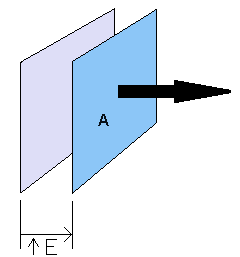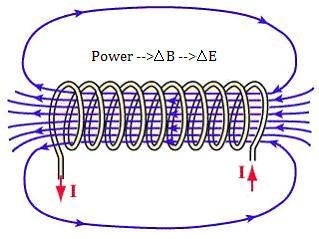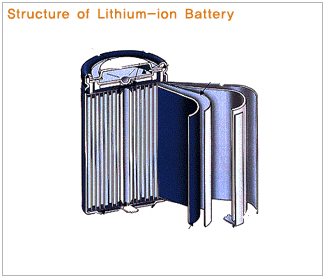Energy Density: Difference between revisions
Jwilliams436 (talk | contribs) No edit summary |
Jwilliams436 (talk | contribs) |
||
| (42 intermediate revisions by the same user not shown) | |||
| Line 1: | Line 1: | ||
by jwilliams436 | by jwilliams436 | ||
Energy Density is the idea that different objects and fields store varying amounts of energy throughout their area. Energy Density can relate to many different concepts, including fuel sources such as food or oil, however the more physics relevant element of energy density is how it relates to Electric and Magnetic fields. | [[File:Energy Density.png|right|The Energy Density of a Positive Charge]]Energy Density is the idea that different objects and fields store varying amounts of [http://physicsbook.gatech.edu/The_Energy_Principle energy] throughout their area. Energy Density can relate to many different concepts, including fuel sources such as food or oil, however the more physics relevant element of energy density is how it relates to energy stored in [http://physicsbook.gatech.edu/Electric_Field Electric] and [http://physicsbook.gatech.edu/Magnetic_Field Magnetic fields]. | ||
To the right, you will see a visual, computational model of what the energy density of a positive point charge might look like. As you can see, there are darker, more opaque shades of red toward the charge. Then, as you look toward the outside of the image, the color becomes more and more translucent and lighter, representing a decreasing Energy Density. | |||
==Sustainable Energy== | =As it Relates to Electric and Magnetic Fields= | ||
==Electric Field== | |||
[[File:CapacitorMoving.png|right|A Moving Capcitor Plate Creating a more energy dense electric field]] | |||
The typical consideration of Energy as it relates to electric fields is the field's interaction with a particle. However, the Energy Density perspective is much more fundamental. It says that energy is physically stored in electric fields. To wrap your head around this idea, imagine a system of two oppositely charged [http://physicsbook.gatech.edu/Capacitor capacitor] plates in which you slowly pull one plate away from the other. In this scenario, the space where there is a sizable electric field increased, due to the energy expended by you. In this sense, energy is stored in the electric field. | |||
===Equation and Units=== | |||
The equation for the Energy Density of an electric field is: | |||
:<math> Energy Density = \frac{\Delta U}{\Delta V} = \frac{\mathbf{E}^2 \varepsilon_0}{2} </math> | |||
Where <math> \Delta U </math> is the [http://physicsbook.gatech.edu/Electric_Potential Potential Energy], <math> \Delta V </math> represents the Volume, <math> \mathbf{E} </math> is the magnitude of the Electric Field, and <math> \varepsilon_0 </math> is the vacuum permittivity constant (8.85e-12). | |||
As you can infer from the above equation, the Unit for Energy Density of an Electric Field is <math> \frac{J}{m^3} </math>. This comes from the fact that Energy is measured in Joules, and volume is measured in meters cubed. | |||
==Magnetic Field== | |||
[[File:SolenoidED.png|right]] | |||
In a similar manner that Energy can be stored in an electric field, there is also an energy density associated with a magnetic field. Typically, Magnetic Energy density is associated with solenoids and inductance. We won't go through the full derivation, however this concept can be visualized by imagining a circuit that includes an inducting solenoid. Because the circuit has a power going into an inductor, there is work being done. This work is translated into increasing the strong magnetic field inside of the solenoid, essentially storing energy in a Magnetic field. | |||
===Equation and Units=== | |||
The equation for the Energy Density of a Magnetic Field looks similar to the equation for the Energy Density of an Electric Field. | |||
:<math> Energy Density = \frac{\Delta U}{\Delta V} = \frac{\mathbf{B}^2}{\mu_0 2} </math> | |||
Where <math> \Delta U </math> is the Potential Energy, <math> \Delta V </math> represents the Volume, <math> \mathbf{B} </math> is the magnitude of the Magnetic Field, and <math> \varepsilon_0 </math> is the magnetic permeability constant (1.25e-6). | |||
The units for Magnetic Field Energy Density are still J/m^3, as Energy Density is still measured as Energy per unit volume. | |||
==Combination of Electric and Magnetic Energy Density== | |||
Typically, the Magnetic and Electric Energy Density Equations will be combined to form one equation that accounts for both fields. | |||
:<math> Energy Density = \frac{\Delta U}{\Delta V} = \frac{\mathbf{E}^2 \varepsilon_0}{2} + \frac{\mathbf{B}^2}{\mu_0 2} </math> | |||
Where all units have the same meanings as above. This equation demonstrates that where there are electric or magnetic fields, there is an associated Energy Density that scales with the magnitude of the field squared. | |||
=Example Problem= | |||
Q: A square region with width <math> 10cm </math> has a constant electric field <math> 10^-6C</math>, and a constant Magnetic Field <math> 4T</math>. Calculate the Energy Density. | |||
A: The first step in this problem is to find the equation for the Energy Density of both an Electric and Magnetic field - | |||
:<math> Energy Density = \frac{\Delta U}{\Delta V} = \frac{\mathbf{E}^2 \varepsilon_0}{2} + \frac{\mathbf{B}^2}{\mu_0 2} </math> | |||
You then plug in values for each known that we have: | |||
:<math> Energy Density = \frac{U}{(.1)*(.1)} = \frac{{(10^-6)}^2 \varepsilon_0}{2} + \frac{{(4)}^2}{\mu_0 2} </math> | |||
You then solve for Potential Energy <math> U </math> using the above equation, and the values of the constants. | |||
:<math> U = 6.35 * 10^6 </math> | |||
After finding this energy, you divide by the area to get the Energy Density. | |||
:<math> Energy Density = \frac{6.35 * 10^6}{(.1) * (.1)} = 6.35 * 10^8 J/m^2 </math> | |||
=High Energy Density Physics= | |||
High Energy Density Physics (HEDP) relates to the interactions of matter that energy densities exceeding roughly <math> 10^11 Joules </math> or more. When energy becomes this dense, the object it is associated with transforms in to a completely new, "4th" state of matter called plasma. Plasma behaves drastically different from other states of matter. For example, under the influence of a magnetic field, it can form unique structures such as filaments and lasers. Currently, there is research going on in this area around fusion plasmas, high intensity lasers, stellar interiors, and supernovae. | |||
=Misc= | |||
==Sustainable Energy (Interest Connection)== | |||
[[File:LIB.png|right]] | |||
There is currently a significant Global Discussion relating to the future of our energy sources. At this point, we have identified that fossil fuels such as oil or coal are not only limited, but also have an extreme negative impact on the environment. For this reason, there is an effort to find energy sources that not only are unlimited and renewable, but also provide the same amount of efficiency (Energy per volume or weight) as current fossil fuels. The problem is that fossil fuels far and away have the highest energy density of almost any current energy source. The table below shows a comparison of Energy Densities of several different popular fuel sources. | There is currently a significant Global Discussion relating to the future of our energy sources. At this point, we have identified that fossil fuels such as oil or coal are not only limited, but also have an extreme negative impact on the environment. For this reason, there is an effort to find energy sources that not only are unlimited and renewable, but also provide the same amount of efficiency (Energy per volume or weight) as current fossil fuels. The problem is that fossil fuels far and away have the highest energy density of almost any current energy source. The table below shows a comparison of Energy Densities of several different popular fuel sources. | ||
| Line 49: | Line 116: | ||
As you can see, the three fossil fuels have much higher energy densities than the more sustainable options near the bottom. The only exception here is Pressurized Hydrogen, which is exceedingly explosive and dangerous. | As you can see, the three fossil fuels have much higher energy densities than the more sustainable options near the bottom. The only exception here is Pressurized Hydrogen, which is exceedingly explosive and dangerous. | ||
For us to truly solve the issue of non-sustainable fuel, the scientists will need to find ways to increase the energy densities of non-fossil fuels before any widespread adoption of them can take place. | For us to truly solve the issue of non-sustainable fuel, the scientists will need to find ways to increase the energy densities of non-fossil fuels that are more renewable before any widespread adoption of them can take place. | ||
===Transportation (Industry Relation)=== | |||
Currently, what is really driving the sustainable energy movement is transportation. Cars are one of, if not the largest consumer of fossil fuels on the planet. As such, this is one of the forefronts of the Energy Density struggle. Being able to make entirely electric transportation would drastically improve the current fossil fuel problem. Due to the popularity of this issue, there are already several electric and hybrid cars on the market. The current issue is that these cars run on batteries that are simply unable to travel the long distances gas-cars can. This is why energy density is important. It would be inefficient to simply have cars with massive batteries, as that is aesthetically unappealing, and expends energy sources at a faster rate. For this reason, researchers are searching for ways to make electric (Or other forms) of energy dense enough to compete with gasoline. | |||
== | ===Mobile Computing (Major Relation)=== | ||
The | The mobile computing market is another area with this concept of energy density is prevalent. Phones and mobile devices are continually improving, having larger screens, faster processors, more RAM -- however all of these things require energy to work properly. However, despite the larger screens, people also want thinner phones. This means that phone companies are constantly trying to make batteries contain larger amount of charge in smaller and smaller forms, essentially trying to increase their energy densities. | ||
==History== | |||
Much of the history of Energy Density is not extremely concrete, especially because it is less of a "discovery" and more of a quality of fields. With this in mind, the concept of Energy density of electric fields has been around since the time of [http://physicsbook.gatech.edu/Charles_de_Coulomb Coulomb] around 1785 in France. Additionally, the magnetic portion of this concept has likely been around since close to 1820 when [http://physicsbook.gatech.edu/Jean-Baptiste_Biot Biot] and [http://physicsbook.gatech.edu/Felix_Savart Savart] made their discovery of the magnetic force, also in France. | |||
== See also == | |||
[1] [[Jean-Baptiste Biot]] | |||
[[ | |||
[2] [[Felix Savart]] | |||
[3] [[Electric Potential]] | |||
[[ | [4] [[Specific Heat Capacity]] | ||
[5] [[Path Independence of Electric Potential]] | |||
[6] [[Energy in a Circuit]] | |||
[7] [[Electric Field]] | |||
[8] [[Electric Force]] | |||
[9] [[Magnetic Field]] | |||
== | ===Further reading and External Links=== | ||
Here are some longer articles and websites where you can find out more about Energy Density. | |||
[1] http://ocw.mit.edu/resources/res-6-001-electromagnetic-fields-and-energy-spring-2008/chapter-11/11.pdf | |||
[2] http://www.imperial.ac.uk/plasma-physics/research/high-energy-density/ | |||
[3] http://www.tinaja.com/glib/energfun.pdf | |||
== | ==References== | ||
[1] http://www.tinaja.com/glib/energfun.pdf | |||
[2] http://hyperphysics.phy-astr.gsu.edu/hbase/electric/indeng.html#c2 | |||
[3] http://hyperphysics.phy-astr.gsu.edu/hbase/quantum/raddens.html | |||
[4] http://ocw.mit.edu/resources/res-6-001-electromagnetic-fields-and-energy-spring-2008/chapter-11/11.pdf | |||
[5] http://www.imperial.ac.uk/plasma-physics/research/high-energy-density/ | |||
[6] Wiley Matter and Interactions Text Book - Electric and Magnetic Interactions | |||
[[Category: | [[Category:Energy]] | ||
Latest revision as of 22:24, 5 December 2015
by jwilliams436

Energy Density is the idea that different objects and fields store varying amounts of energy throughout their area. Energy Density can relate to many different concepts, including fuel sources such as food or oil, however the more physics relevant element of energy density is how it relates to energy stored in Electric and Magnetic fields.
To the right, you will see a visual, computational model of what the energy density of a positive point charge might look like. As you can see, there are darker, more opaque shades of red toward the charge. Then, as you look toward the outside of the image, the color becomes more and more translucent and lighter, representing a decreasing Energy Density.
As it Relates to Electric and Magnetic Fields
Electric Field

The typical consideration of Energy as it relates to electric fields is the field's interaction with a particle. However, the Energy Density perspective is much more fundamental. It says that energy is physically stored in electric fields. To wrap your head around this idea, imagine a system of two oppositely charged capacitor plates in which you slowly pull one plate away from the other. In this scenario, the space where there is a sizable electric field increased, due to the energy expended by you. In this sense, energy is stored in the electric field.
Equation and Units
The equation for the Energy Density of an electric field is:
- [math]\displaystyle{ Energy Density = \frac{\Delta U}{\Delta V} = \frac{\mathbf{E}^2 \varepsilon_0}{2} }[/math]
Where [math]\displaystyle{ \Delta U }[/math] is the Potential Energy, [math]\displaystyle{ \Delta V }[/math] represents the Volume, [math]\displaystyle{ \mathbf{E} }[/math] is the magnitude of the Electric Field, and [math]\displaystyle{ \varepsilon_0 }[/math] is the vacuum permittivity constant (8.85e-12).
As you can infer from the above equation, the Unit for Energy Density of an Electric Field is [math]\displaystyle{ \frac{J}{m^3} }[/math]. This comes from the fact that Energy is measured in Joules, and volume is measured in meters cubed.
Magnetic Field

In a similar manner that Energy can be stored in an electric field, there is also an energy density associated with a magnetic field. Typically, Magnetic Energy density is associated with solenoids and inductance. We won't go through the full derivation, however this concept can be visualized by imagining a circuit that includes an inducting solenoid. Because the circuit has a power going into an inductor, there is work being done. This work is translated into increasing the strong magnetic field inside of the solenoid, essentially storing energy in a Magnetic field.
Equation and Units
The equation for the Energy Density of a Magnetic Field looks similar to the equation for the Energy Density of an Electric Field.
- [math]\displaystyle{ Energy Density = \frac{\Delta U}{\Delta V} = \frac{\mathbf{B}^2}{\mu_0 2} }[/math]
Where [math]\displaystyle{ \Delta U }[/math] is the Potential Energy, [math]\displaystyle{ \Delta V }[/math] represents the Volume, [math]\displaystyle{ \mathbf{B} }[/math] is the magnitude of the Magnetic Field, and [math]\displaystyle{ \varepsilon_0 }[/math] is the magnetic permeability constant (1.25e-6).
The units for Magnetic Field Energy Density are still J/m^3, as Energy Density is still measured as Energy per unit volume.
Combination of Electric and Magnetic Energy Density
Typically, the Magnetic and Electric Energy Density Equations will be combined to form one equation that accounts for both fields.
- [math]\displaystyle{ Energy Density = \frac{\Delta U}{\Delta V} = \frac{\mathbf{E}^2 \varepsilon_0}{2} + \frac{\mathbf{B}^2}{\mu_0 2} }[/math]
Where all units have the same meanings as above. This equation demonstrates that where there are electric or magnetic fields, there is an associated Energy Density that scales with the magnitude of the field squared.
Example Problem
Q: A square region with width [math]\displaystyle{ 10cm }[/math] has a constant electric field [math]\displaystyle{ 10^-6C }[/math], and a constant Magnetic Field [math]\displaystyle{ 4T }[/math]. Calculate the Energy Density.
A: The first step in this problem is to find the equation for the Energy Density of both an Electric and Magnetic field -
- [math]\displaystyle{ Energy Density = \frac{\Delta U}{\Delta V} = \frac{\mathbf{E}^2 \varepsilon_0}{2} + \frac{\mathbf{B}^2}{\mu_0 2} }[/math]
You then plug in values for each known that we have:
- [math]\displaystyle{ Energy Density = \frac{U}{(.1)*(.1)} = \frac{{(10^-6)}^2 \varepsilon_0}{2} + \frac{{(4)}^2}{\mu_0 2} }[/math]
You then solve for Potential Energy [math]\displaystyle{ U }[/math] using the above equation, and the values of the constants.
- [math]\displaystyle{ U = 6.35 * 10^6 }[/math]
After finding this energy, you divide by the area to get the Energy Density.
- [math]\displaystyle{ Energy Density = \frac{6.35 * 10^6}{(.1) * (.1)} = 6.35 * 10^8 J/m^2 }[/math]
High Energy Density Physics
High Energy Density Physics (HEDP) relates to the interactions of matter that energy densities exceeding roughly [math]\displaystyle{ 10^11 Joules }[/math] or more. When energy becomes this dense, the object it is associated with transforms in to a completely new, "4th" state of matter called plasma. Plasma behaves drastically different from other states of matter. For example, under the influence of a magnetic field, it can form unique structures such as filaments and lasers. Currently, there is research going on in this area around fusion plasmas, high intensity lasers, stellar interiors, and supernovae.
Misc
Sustainable Energy (Interest Connection)

There is currently a significant Global Discussion relating to the future of our energy sources. At this point, we have identified that fossil fuels such as oil or coal are not only limited, but also have an extreme negative impact on the environment. For this reason, there is an effort to find energy sources that not only are unlimited and renewable, but also provide the same amount of efficiency (Energy per volume or weight) as current fossil fuels. The problem is that fossil fuels far and away have the highest energy density of almost any current energy source. The table below shows a comparison of Energy Densities of several different popular fuel sources.
| Fuel Source | Energy Density (Wh/Kg) | Energy Density (Wh/L) |
|---|---|---|
| Gasoline | 9,000 | 13,500 |
| Propane | 6,600 | 13,900 |
| Ethanol | 6,100 | 7,850 |
| Liquid Hydrogen | 2,600 | 39,000 |
| Lithium Ion Battery | 250 | 350 |
| Liquid Nitrogen | 65 | 55 |
| Compressed Air | 17 | 34 |
As you can see, the three fossil fuels have much higher energy densities than the more sustainable options near the bottom. The only exception here is Pressurized Hydrogen, which is exceedingly explosive and dangerous.
For us to truly solve the issue of non-sustainable fuel, the scientists will need to find ways to increase the energy densities of non-fossil fuels that are more renewable before any widespread adoption of them can take place.
Transportation (Industry Relation)
Currently, what is really driving the sustainable energy movement is transportation. Cars are one of, if not the largest consumer of fossil fuels on the planet. As such, this is one of the forefronts of the Energy Density struggle. Being able to make entirely electric transportation would drastically improve the current fossil fuel problem. Due to the popularity of this issue, there are already several electric and hybrid cars on the market. The current issue is that these cars run on batteries that are simply unable to travel the long distances gas-cars can. This is why energy density is important. It would be inefficient to simply have cars with massive batteries, as that is aesthetically unappealing, and expends energy sources at a faster rate. For this reason, researchers are searching for ways to make electric (Or other forms) of energy dense enough to compete with gasoline.
Mobile Computing (Major Relation)
The mobile computing market is another area with this concept of energy density is prevalent. Phones and mobile devices are continually improving, having larger screens, faster processors, more RAM -- however all of these things require energy to work properly. However, despite the larger screens, people also want thinner phones. This means that phone companies are constantly trying to make batteries contain larger amount of charge in smaller and smaller forms, essentially trying to increase their energy densities.
History
Much of the history of Energy Density is not extremely concrete, especially because it is less of a "discovery" and more of a quality of fields. With this in mind, the concept of Energy density of electric fields has been around since the time of Coulomb around 1785 in France. Additionally, the magnetic portion of this concept has likely been around since close to 1820 when Biot and Savart made their discovery of the magnetic force, also in France.
See also
[2] Felix Savart
[5] Path Independence of Electric Potential
[7] Electric Field
[8] Electric Force
[9] Magnetic Field
Further reading and External Links
Here are some longer articles and websites where you can find out more about Energy Density.
[2] http://www.imperial.ac.uk/plasma-physics/research/high-energy-density/
[3] http://www.tinaja.com/glib/energfun.pdf
References
[1] http://www.tinaja.com/glib/energfun.pdf
[2] http://hyperphysics.phy-astr.gsu.edu/hbase/electric/indeng.html#c2
[3] http://hyperphysics.phy-astr.gsu.edu/hbase/quantum/raddens.html
[5] http://www.imperial.ac.uk/plasma-physics/research/high-energy-density/
[6] Wiley Matter and Interactions Text Book - Electric and Magnetic Interactions